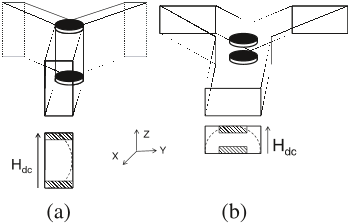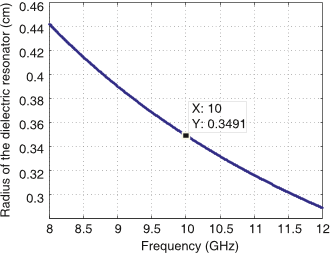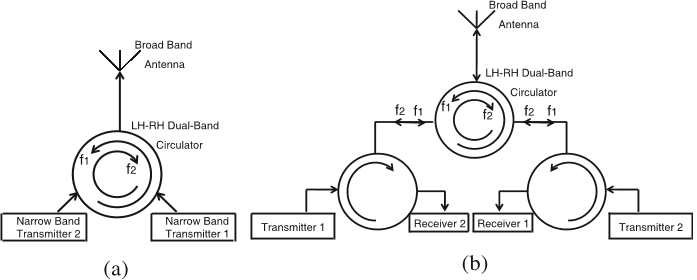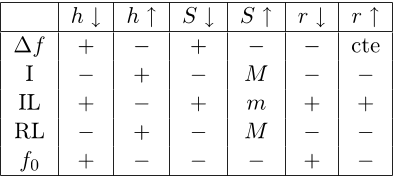
Progress In Electromagnetics Research C, Vol. 10, 15–24, 2009
A NEW DUAL-BAND HIGH POWER FERRITE
CIRCULATOR
H. Razavip our, R. Safian, G. Askari, F. Fesharaki
and H. Mirmohamad Sadeghi
Information and Communication Technology Institute
Isfahan University of Technology
Isfahan, Iran
Abstract—The design, simulation and performance enhancement of
a new structure for X-band high-power, low-loss, low-bias, triangular-
ferrite waveguide circulator are presented. Dual circulation property is
obtained by triangular shape of ferrite post. The effects of circulator’s
structure parameters, such as ferrite parameters and magnetic DC bias,
on isolation, insertion loss and return loss of circulator are discussed.
The HFSS software is used for simulating the circulators. Final
dual band designs with 20 dB return loss, 20 dB isolation and 0.1 dB
insertion loss in dual frequency in X-band (8.2 GHz and 10.4 GHz) with
only a magnetic bias of 10 Oe are obtained.
1. INTRODUCTION
Circulator is a versatile microwave device which plays an important
role in satellite communications and radar applications. There are two
different kinds of circulators, E-plane and H-plane, which are based
on the two main categories of waveguides. Figures 1(a) and (b) show
the three dimensional view and the location of the ferrite in a two
dimensional view of E- and H-plane circulators. Each of them has
advantages which stems from the properties of the waveguide used as
the guiding structure or the location of the ferrite in the circulator
structure. In general, the power handeling of the E-plane circulator
is higher than the H-plane. This is due to the fact that the ferrite
is located at the point where the electric field is minimum in the
waveguide. In addition, RF losses caused by the dielectric properties
of the ferrite will be smaller, thereby reducing the heating effects.
Corresponding author: R. Safian (rsafian@cc.iut.ac.ir).

16 Razavipour et al.
H
dc
H
Z
X
Y
dc
(a) (b)
Figure 1. Geometries of E-plane and H-plane junctions of waveguide
circulators. Dotted line = Electric field intensity.
Another problem that reduces the handling of high-power application
is that ferrite is a brittle material. Increasing the amplitude of one of
E or H fields to extremely high value in the ferrite region may tends to
ferrite crashing. An optimum way to keep it safe against any damage
is to place it in a dielectric substrate.
There have been several theoretical attempts to analyze and design
different E-plane waveguide circulators [7, 9]. These analysis has led to
different physical implementations of E-plane circulators [1–4]. But,
as far as we know there has not been any theocratical or experimental
attempts to design dual band circulator in the literature. In this paper,
a design procedure for high-power, dual-band or Left-Handed Right-
Handed (LH-RH) dual-band circulator is presented. The Ansoft HFSS
software is employed to optimize the response of circulator.The first
part includes a brief theory of the dual band ferrite circulator and
different techniques which can be used to increase the bandwidth and
decrease the insertion loss. The second part includes the design process
and optimization results.
2. THEORY OF THE DUAL BAND CIRCULATOR
In the first Section 2.1 general description of a dual band circulator
in terms of its ideal scattering parameters is presented. A practical
example which shows the application of the dual band circulator in
a transmitter system is also included in this section. In the next
two sections different techniques which can be used to achieve wider
bandwidth and lower reflection loss are discussed. The last Section 2.4
talks about the modal distribution of the ferrite inside the circulator.

Progress In Electromagnetics Research C, Vol. 10, 2009 17
2.1. Dual Band Circulator
In general, circulators are three port networks. Hence, the associated
scattering parameters matrix is a 3 by 3 matrix. There are two possible
representation for a lossless circulator which is defined as S
LH
and S
RH
with S parameter matrices,
S
LH
=
Ã
0 0 1
1 0 0
0 1 0
!
S
RH
=
Ã
0 1 0
0 0 1
1 0 0
!
In a “left handed circulator” (LHC) which is defined by S
LH
the signal
circles counterclockwise and in the “right hand circulator” (RH) which
is defined by S
RH
the signal circle in the clockwise direction. Any single
band circulator adopts one of these arrangements.
In a dual band circulator there are two possible demonstration.
A regular dual band circulator has right hand or left hand circulation
in two different frequency bands. But, another possibility is a “LH-
RH dual band circulator” which has right hand circulation in one
frequency band and left hand circulation in an other one. Left hand-
right hand (LH-RH) circulators can be used as power combiner in
dual-band or multi-band transmitters [13] or in Radar applications.
As illustrated in Figure 2(a), a LH-RH dual-band circulator can be
used to mix two high power transmitters and send the signals with one
broadband antenna. At the same time, the system provides proper
isolation between two transmitters for multiplexing different channels.
Another application (Figure 2(b)) is implementing the power sections
of a dual-band radar by means of two simple dual-band circulators (or
two broadband circulators) and one LH-RH dual-band circulator.
f1
f2
f2 f1
f1
f2
Broad Band
Antenna
Narrow Band
Transmitter 1
LH-RH Dual-Band
Circulator
(a)
f1
f2
(b)
Broad Band
Antenna
LH-RH Dual-Band
Circulator
Transmitter 1
Receiver 2 Receiver 1
Transmitter 2
Narrow Band
Transmitter 2
Figure 2. Schematics of two applications for LH-RH dual-band E-
plane circulator.

18 Razavipour et al.
2.2. Bandwidth
One important property of a circulator is its bandwidth which is
different for E- and H-plane structures. Although E-plane circulators
have the capability of high power handeling, generally their bandwidth
is narrower compared to the H-plane structures. Hence, in general
there is a tradeoff between bandwidth and high-power handling
properties. The physical structure of the E- and H-plane waveguides
dictates this trade-off. In most of the applications the high power
capability is superior to the bandwidth, hence, most of the circulators
are E-plane. But, some specific alteration in the ferrite structure
may lead to increasing the bandwidth in the E-plane structure.
For example, increasing the height of the ferrite post increases the
bandwidth. But, as the result of increasing the length of the ferrite,
concentration of the peak of T E
10
mode in the ferrite region increases
which decreases the high-power capability of the circulator. Another
way to to broaden the bandwidth is done by improving the impedance
match of the ferrite junction. A well known technique is placing a
stack of thin dielectric disks of diminishing dielectric constant on top
of each ferrite disk [14]. Adding a single dielectric would also increase
the bandwidth but it has a lower impact. Here, we have placed two
short lengths of the ferrite on both sides of the E-plane waveguide to
increase the high power capability of the circulator. Also, the space
between the two pieces of ferrite is filled with a dielectric to increase
the bandwidth (Figure 3).
2.3. Reflection Loss
The shape of the ferrite post plays an important role in matching of
the junction to the waveguide structure. In general tapering the cross
section of the ferrite in the direction of the incident wave decreases the
reflection loss. The triangular intersection is used in several cases [8, 15]
to decrease the reflection loss. As illustrated in Figure 4, implementing
the triangular ferrite can be done in two different geometries. Based on
the performed simulations structure (a) has a better insertion loss than
(b). This is due to the fact that the propagating wave in Figure 4(a)
hits the tapered side of the ferrite post while in Figure 4(b) it faces
with the flat surface of ferrite post, so the reflection in Figure 4(b)
is considerably larger than the reflection of tapered ferrite in the
geometry of Figure 4(a).

Progress In Electromagnetics Research C, Vol. 10, 2009 19
r
h
d
Figure 3. Physical geom-
etry of the triangular fer-
rite posts and the dielec-
tric filling around them.
(a) (b)
Figure 4. Geometries of two kinds
of ferrite placement in the waveguide
junction.
2.4. Modal Description of the Ferrite in E-plane Circulator
To simplify the analysis of the structure we have assumed that the
ferrite post and the dielectric filling have similar dielectric constant.
Hence, we can assume that the combination of the ferrite and the
dielectric filling form a cylindrical dielectric resonator. The theory of
fundamental cylindrical dielectric resonator mode presented in [5, 6].
Based on this approximation the lowest order mode of the ferrite
resonator is the T M
111
mode which is the dominant cylindrical
dielectric resonator. In the E-plane circulator the half height ferrite is
placed on the side wall of a waveguide as shown in Figure 1. The normal
mode components, E
z
and H
y
of the T E
10
waveguide can couple to the
similar field components of the ferrite resonator. The application of a
dc magnetic field in the Z direction will reorient the standing wave of
the resonator. With a proper reorientation a three-port circulator will
be obtained. The reorientation of the standing wave is caused by the
splitting of the T M
111
mode into the T M
+
111
and T M
−
111
modes by the
tensor permeability of the ferrite resonator. These modes correspond
to right-handed and left-handed circular polarization respectively. By
controlling the degree of this split, it is p ossible to adjust the resonant
frequency of circulator for gaining a nonreciprocal response.
Assuming the dielectric resonator fills the full height of the
waveguide junction, the approximate center frequency of the split mode
in free space is [5, 10–12],
2πr
λ
0
r
²µ
eff
−
λ
0
2L
= 1.84 (1)
where λ
0
is the free space wavelength, r is the radius of the cavity, ² is
the relative permittivity, µ
eff
is the relative effective permeability and





